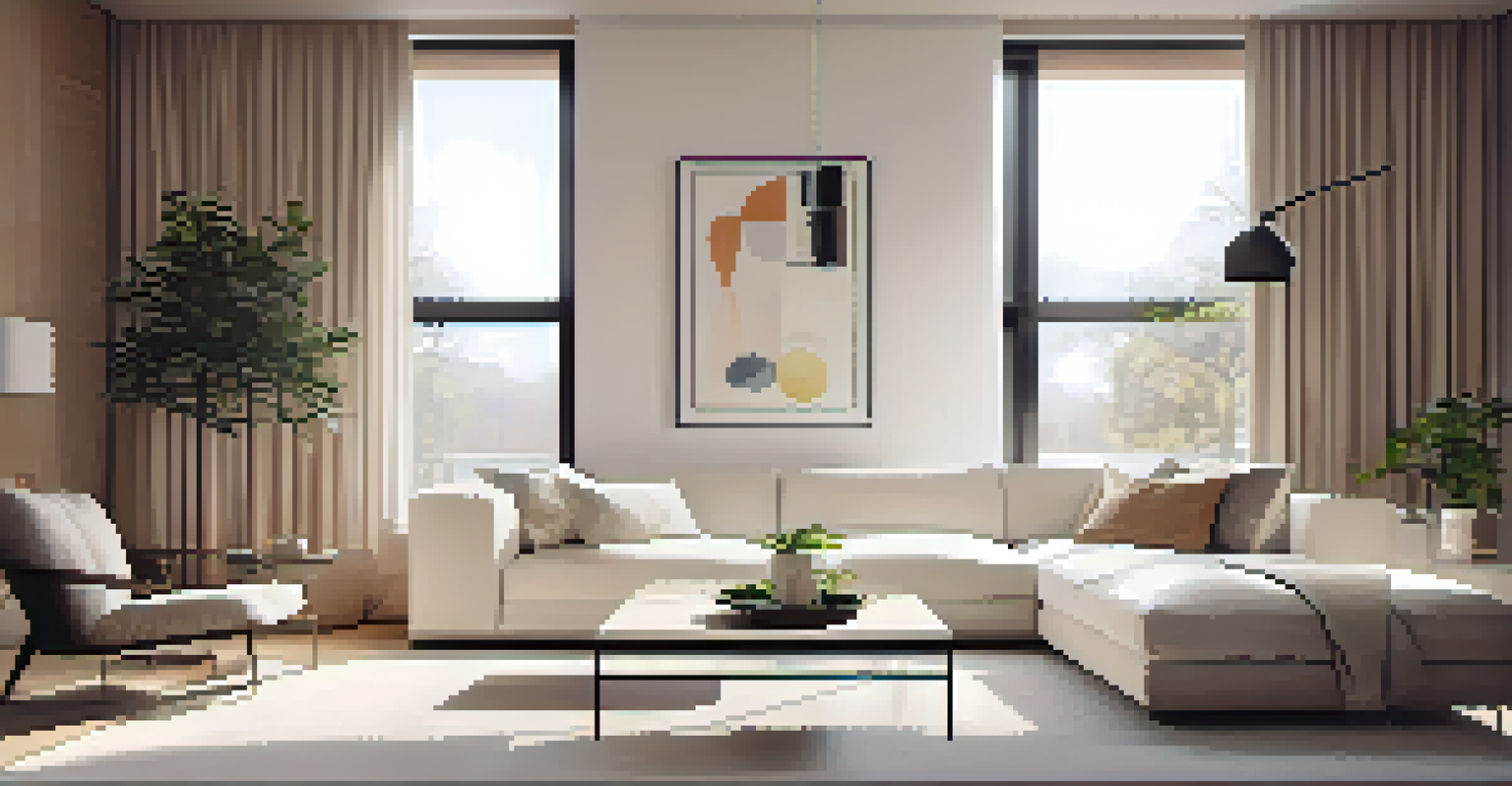Minimalism and Its Impact on Modern Art Practices

Understanding Minimalism: A Brief Overview
Minimalism emerged as an art movement in the late 1950s, emphasizing simplicity and the stripping away of excess. Artists sought to reduce their work to its essential elements, often utilizing geometric forms and limited color palettes. This approach was a response to the complexity of abstract expressionism, prioritizing clarity and directness instead.
Simplicity is the ultimate sophistication.
At its core, minimalism invites viewers to engage with the artwork on a deeper level. By removing distractions, artists encourage a focus on the materials and the space they inhabit. This dialogue between the viewer and the art encourages contemplation and a more thoughtful experience.
Minimalism extends beyond visual art—it has influenced architecture, design, and lifestyle choices. The philosophy of minimalism promotes the idea that less can indeed be more, allowing individuals and artists alike to find beauty in simplicity.
The Transition from Abstract Expressionism to Minimalism
In the mid-20th century, abstract expressionism dominated the art scene, characterized by emotional intensity and complex compositions. Artists like Jackson Pollock and Mark Rothko created works that often overwhelmed viewers with color and form. However, minimalist artists sought to break away from this emotional weight, opting for a more restrained approach.

This shift was not just about aesthetics; it reflected changing societal values. As post-war America grappled with consumerism and materialism, minimalism emerged as a reaction against these trends. Artists like Donald Judd and Agnes Martin represented this new wave, focusing on the purity of form over emotional expression.
Minimalism Transforms Artistic Expression
Minimalism reshaped the art world by emphasizing simplicity and clarity, allowing for deeper engagement with the viewer.
The contrast between these two movements illustrates a broader conversation in art: the tension between complexity and simplicity. This transition paved the way for contemporary artists to explore minimalism's potential, leading to new interpretations and applications in modern art practices.
Key Figures in Minimalism and Their Contributions
Several artists have become synonymous with the minimalist movement, each contributing a unique perspective. Donald Judd, known for his geometric sculptures, emphasized the importance of space and structure, often creating works that interacted with their surroundings. His pieces invite viewers to consider the relationship between art and environment.
The more one knows, the more one can reduce one's work to its essentials.
Agnes Martin, another pivotal figure, approached minimalism through a different lens, focusing on subtlety and tranquility. Her works, often characterized by delicate lines and soft colors, evoke feelings of peace and introspection. Martin's art challenges the notion that minimalism must always be stark or cold.
Other influential figures, such as Dan Flavin and Carl Andre, expanded minimalism into new mediums, exploring light and materials in innovative ways. Each artist's unique contributions have helped shape the landscape of modern art, demonstrating the versatility and depth of minimalist philosophy.
Minimalism's Role in Contemporary Art Practices
Today, minimalism continues to influence contemporary art in diverse ways. Many modern artists draw inspiration from minimalist principles, infusing their work with simplicity while exploring complex themes. This blend of minimalism with other styles creates a rich tapestry of artistic expression.
For instance, artists like Yayoi Kusama incorporate minimalism into their immersive installations, inviting viewers to experience art in a multi-sensory environment. By merging minimal elements with bold patterns, she challenges traditional boundaries and encourages new interpretations.
Influence Beyond Visual Arts
The principles of minimalism extend into architecture, design, and even digital art, showcasing its adaptability and relevance.
Moreover, minimalism's impact is not just confined to visual art; it has seeped into practices like photography and digital art. The emphasis on clarity and focus resonates in various forms, proving that minimalist principles are adaptable and relevant in the ever-evolving art world.
The Intersection of Minimalism and Digital Art
As technology advances, the intersection of minimalism and digital art becomes increasingly prominent. Digital artists often embrace minimalist aesthetics, using clean lines and simple compositions to convey their messages. This approach aligns well with the digital medium, where clarity and accessibility are paramount.
For example, web design has adopted minimalist principles, prioritizing functionality and user experience. A clean layout, with ample white space and straightforward navigation, enhances usability, making information easy to digest. This trend reflects minimalism’s broader influence on how we consume and interact with visual content.
Furthermore, artists like Casey Reas and Manfred Mohr utilize algorithms and code to create minimalist digital artworks. Their works highlight the beauty of simplicity in a medium that can often be overwhelming, bridging the gap between traditional minimalism and contemporary digital practices.
Challenges and Critiques of Minimalism
Despite its appeal, minimalism is not without its challenges and critiques. Some argue that the movement can be overly elitist, favoring certain interpretations and excluding diverse voices. This critique raises important questions about accessibility and the democratization of art.
Additionally, the notion of 'less is more' can sometimes lead to an oversimplification of complex ideas. Critics suggest that minimalism may mask deeper socio-political issues, reducing the rich narratives of contemporary life to mere aesthetics. This tension invites ongoing dialogue within the art community about the role of minimalism.
Future of Minimalism is Evolving
As sustainability becomes more important, minimalism will continue to inspire artists to blend simplicity with innovative themes.
Nonetheless, these challenges have prompted many artists to find innovative ways to incorporate minimalism while addressing broader themes. By engaging with social issues through a minimalist lens, artists can create works that are both visually striking and thought-provoking.
The Future of Minimalism in Art and Culture
As we look to the future, minimalism's influence is likely to endure and evolve. With the rise of sustainability and environmental consciousness, artists are increasingly exploring minimalist principles as a way to promote mindful consumption and living. This shift aligns with the idea that art can provoke change and inspire action.
Moreover, the fusion of minimalism with other art movements will continue to spark creativity and innovation. Artists may blend minimalism with more expressive styles, creating dynamic works that challenge viewers while remaining grounded in simplicity. This ongoing dialogue between different artistic approaches keeps the spirit of minimalism alive and relevant.

Ultimately, minimalism serves as a reminder of the power of simplicity in a world often filled with noise and distraction. As artists navigate the complexities of modern life, the minimalist ethos offers a pathway to clarity, inviting us all to appreciate the beauty found in simplicity.